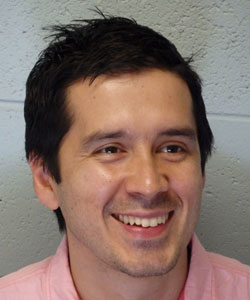Griffith University is among a select of group universities chosen to conduct joint research with US universities on priority defence projects.
Griffith, along with University of NSW, Sydney University and the University of Technology Sydney, were announced by the Minister for Defence Industry, Christopher Pyne as the four Australian universities to help conduct the research, which will come under the auspices of the US Department of Defense Multidisciplinary University Research Initiative (MURI).
“This success is testament to the strength of quantum research at Griffith, and in our collaborating institutions” said Professor Howard Wiseman, who is the Director of Griffith’s Centre for Quantum Dynamics and one of the chief investigators in the project.
The MURI project, titled “quantum control based on real-time environment analysis by spectator qubits”, is led in Australia by Griffith Research Fellow Dr Gerardo Paz Silva.

Dr Gerardo Paz Silva
“The research is an exciting multidisciplinary project that will be executed by a team of experts in the field of quantum control, silicon-based quantum technologies, and machine learning,” he said.
Mr Pyne congratulated the Australian universities, saying the Next Generation Technologies Fund supported their success.
He said it was the first time Defence had funded Australian universities to work with their US counterparts.
“As these universities were chosen from a pool of over 400 proposals, this is a great outcome, one which shows that Australian researchers are world class,” Mr Pyne said.
Mr Pyne said Griffith, University of NSW and University of Technology Sydney would work with Duke University, the University of Oregon and the Massachusetts Institute of Technology, Johns Hopkins Applied Physics Laboratory, Dartmouth College, Lousiana State University and University of California on integrated quantum sensing and control for high-fidelity qubit operations, while Sydney University and the University of NSW are to partner with the University of Tennessee, Ohio State University and Virginia Polytechnic Institute on a project in material sciences.
He said the Australian universities would each receive a grant of up to $1 million a year for three years to support their research in Australia, with the possibility of extending to five years.Professor Wiseman and Dr Paz Silva from Griffith, Dr Christopher Ferrie fromUniversity of Technology Sydney, and Professor Andrea Morella fromUniversity of NSW represent the Australian universities on the project.
AUSMURI scheme awards quantum project $3 million
The MURI project “quantum control based on real-time environment analysis by spectator qubits”, led in Australia by Griffith Research FellowDr Paz Silva, was awarded a grant of $3 million under the AUSMURI scheme.
Dr Paz Silva said $1 million of the $3 million grant would be used to buy hardware for the experimental part of the project, and $2 million would be used to hire the personnel to drive the project.
“We hope at the end of the day we have developed all the tools to have an Australian-based prototype for the technology we are trying to develop.”
The project’s objective is to protect quantum bits (qubits) from external noise in real time while manipulating them with high precision, using a multidisciplinary approach involving new experimental methods and theoretical tools, supported by advanced machine learning routines.
“The grant win was a huge boost for us and it gives validation to the work we are doing. We had been working on similar ideas before but moving towards this direction, so the grant win implies that we are on the right track,” Dr Paz Silva said.
“We’re hoping that it will be an important step towards achieving the incredibly high fidelities necessary to realise the dream of quantum computing.
“A working quantum computer will be able to solve complexcomputations that are incredibly hard for normal (classical) computers, in practical time scales. This will fundamentally change the types of problems we can realistically solve and will have implications in all areas on society, ranging from medicine to defence.”
